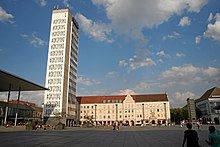Iris reason
Iris Grund , also Iris Dullin-Grund , (born March 16, 1933 in Berlin as Iris Dullin ) is a German architect and urban planner. Their work was focused on Neubrandenburg , which the GDR leadership was to develop into an ambitious urban development program to become a metropolitan center in the north of the republic; this took place from 1970 onwards under the responsibility of a city architect. She was one of the most influential architects in the GDR.
Live and act
From 1952 to 1957, Grund studied architecture at the Berlin-Weißensee School of Art, among others with Selman Selmanagic . After completing her studies, she worked for two years in the office of Hermann Henselmann , one of the most renowned architects in the GDR, and briefly in 1959 with Ernst May in Hamburg. However, she returned to the GDR in the same year out of political conviction. In 1959 the 26-year-old architect won the tender for the House of Culture and Education in Neubrandenburg , which was inaugurated in 1965 and of which she was the city architect from 1970 to 1990. The position of urban architect was the highest that an architect could achieve in the GDR. At the same time, no woman in the Federal Republic of Germany had succeeded in doing anything like it. Another woman rose to this management position in the GDR. In 1968 she was appointed to the German Building Academy in East Berlin , where she was awarded a Dr.-Ing. doctorate and of which she remained until the dissolution of the GDR in 1990. As a city architect, she was in charge of the pilot project for the 70 series of residential buildings , a renovation of the prefabricated construction method aimed at greater efficiency and flexibility, especially in the GDR, which was ready for occupancy in 1973 in the East-German town of Neubrandenburg .
Dullin-Grund was recognized beyond the borders of the GDR because of the House of Culture and Education ( Kulturfinger ) in Neubrandenburg and the innovative general development plan for this city. Numerous magazine articles have appeared about her and she has received high-ranking architecture awards. In 1980 she became a member of the scientific council of the German Building Academy. Only one other woman was a member of this body.
After the fall of the Wall, she had her own architecture office in Berlin. During this time she built, among other things, the sports and festival hall in Lychen (1995) and a place to live and work in Berlin-Alt-Stralau (1998) and was responsible for converting a former LPG on the Neu Gaarz estate in the Mecklenburg Lake District into a hotel (1999). From 1999 to 2008 she had a second architecture office on the Côte d'Azur .
Iris Grund lives as a freelance architect in Glienecke near Berlin.
Iris Grund was one of 22 architects whose professional life and work were presented in the exhibition Frau Architekt at the German Architecture Museum in Frankfurt am Main , which ran from September 2017 to March 2018 .
In 1969 Lea Grundig drew the Neubrandenburg city architect.
Awards
- 1976 Schinkel Medal
- 1977 Architecture Prize of the GDR
- 1981 Schinkel Medal
Publications (selection)
- Neubrandenburg, House of Culture and Education. Leipzig 1969
- Buildings for cultural leisure activities as part of the socialist living environment and their urban and spatial organization. Berlin 1971
- Joachim Schulz (Ed.): Neubrandenburg - Stadt und Umgebung , Berlin 1991 ("with the help" of Iris Grund)
- Story of an architect. Visions and reality. Autobiography. My book, Hamburg 2004. ISBN 3-86516-152-9 .
Web links
- Literature by and about Iris Grund in the catalog of the German National Library
- Literature about Iris Grund in the state bibliography MV
- Dr. Iris reason. In: arch INFORM . (biographical information with a tabular curriculum vitae)
- Iris Dullin-Grund. In: everyone-qm-du.de.
- Tanja Scheffler: BAUWELT - the great unknowns - architects of the GDR. In: bauwelt.de. 1st November 2017 .
References and comments
- ↑ Dr. Iris reason. In: arch INFORM .
- ^ A b Petra Lohmann: Urban architect in socialism: Iris Dullin-Grund . In: Mary Pepchinski, Christina Budde, Wolfgang Voigt, Peter Cachola Schmal (eds.): Frau Architekt. For more than 100 years: women in the architectural profession . Wasmuth, Tübingen 2017, ISBN 978-3-8030-0829-9 , pp. 197–201, 297–298, here 197 .
- ↑ In the same entry on archINFORM, the doctorate is dated 1969 and 1970. In the information in the Kalliope network , 1971 is given as the dissertation year.
- ↑ Jan Zwilling (September 29, 2016): Study on women architects in the GDR , at the Leibniz Institute for Spatial Social Research (IRS), published in Informationsdienst Wissenschaft
- ^ Danuta Schmidt: GDR architecture was more than three rooms, a kitchen and a bathroom. In: tlz.de. June 30, 2013, accessed December 24, 2019 .
- ↑ a b c d Lohmann 2017 p. 198.
- ↑ a b Lohmann 2017 p. 201.
- ↑ DAM. FRAU ARCHITECT - For more than 100 years: women in the architectural profession. In: dam-online.de. Archived from the original on October 17, 2017 ; accessed on December 24, 2019 .
- ↑ Oststadt was born in 1959 - meckpress's freelance journalist, author, ghostwriter in Mecklenburg. Urban architect Iris Grund, drawn in 1969 by Lea Grundig, a member of the Central Committee of the SED, who died in 1977. In: meckpress.de. Retrieved December 24, 2019 .
| personal data | |
|---|---|
| SURNAME | Reason, Iris |
| ALTERNATIVE NAMES | Dullin Ground, Iris; Dullin, Iris |
| BRIEF DESCRIPTION | German architect |
| DATE OF BIRTH | March 16, 1933 |
| PLACE OF BIRTH | Berlin |


